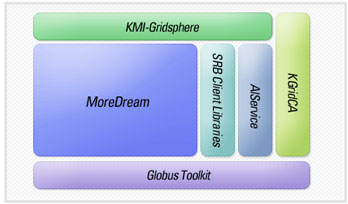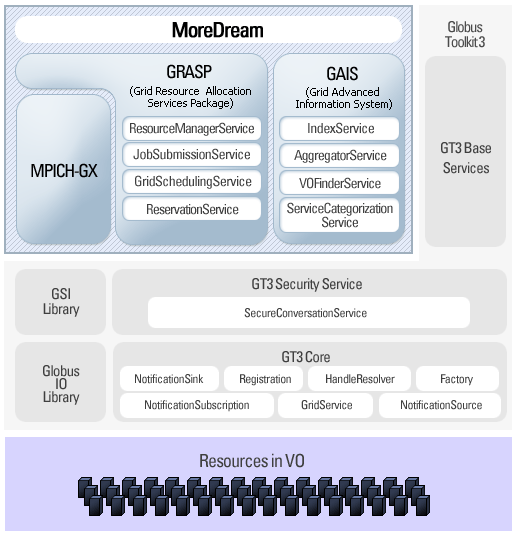K*Grid middleware has been developed as a part of the K*Grid project. KMI-R1 (K*Grid Middleware Initiative - Release 1) is an integrated Grid middleware package that helps scientists to easily setup computational and data Grid environments for their research as well as harness all the advantages of Grid at their fingertips. KMI was originally developed for the K*Grid infrastructure (see Figure 1) but is not limited to it. KMI-R1 is an integration of the MoreDream Toolkit (developed by KISTI) with some key software packages such as Globus Toolkit (developed by ANL), KGridCA system (developed by KISTI) for the Grid certificate authority service, AIService (developed by KISTI) for the Grid accounting service, SRB (Storage Resource Broker, developed by SDSC), and KMI-GridSphere (optimized with GridSphere developed by GridLab).

MoreDream is a Grid middleware toolkit which allows scientists in many application areas to easily use the Grid environment and to utilize necessary resources, such as computing resources, data, storage, and experts geographically and organizationally distributed. In the MoreDream project, three research issues beneficial to scientists are the foci. The major components of MoreDream (Figure 2) are GRASP (Grid Resource Allocation Services Package) for Grid resource allocation service, GAIS (Grid Advanced Information System) for Grid information service, and MPICH-GX for parallel computing service. Each component has extended functionalities of the Globus Toolkit 3 (GT3). The services of MoreDream are implemented based on the OGSI (Open Grid Service Infrastructure) of GT3.

Currently, managed job service in GT3 is to be used to run a job on a remote resource. However, in order to build a more useful Grid, there should be additional user-friendly resource allocation, including resource brokering, scheduling, monitoring, and so forth. To meet this requirement in the Grid resource management area, we designed and implemented a resource allocation system named GRASP, which is to allow users to submit their jobs in a more efficient and intelligent manner. The services of GRASP were implemented based on the OGSI. GAIS is an OGSI-compliant information system that extends GT3 MDS3 and conforms to a flat and dynamic architecture. It provides more plentiful resource information and advanced functionalities in order to satisfy the requirements for various Grid applications in the K*Grid. MPICH-GX is an enhancement of MPICH-G2, extending functionalities required in the Grid. MPICH-G2 is a well-defined implementation of Grid-enabled MPI, but it need to be modified for supporting some requirements of Grid applications. The detailed information about all the components of KMI-R1 can be found at http://kmi.moredream.org/.






